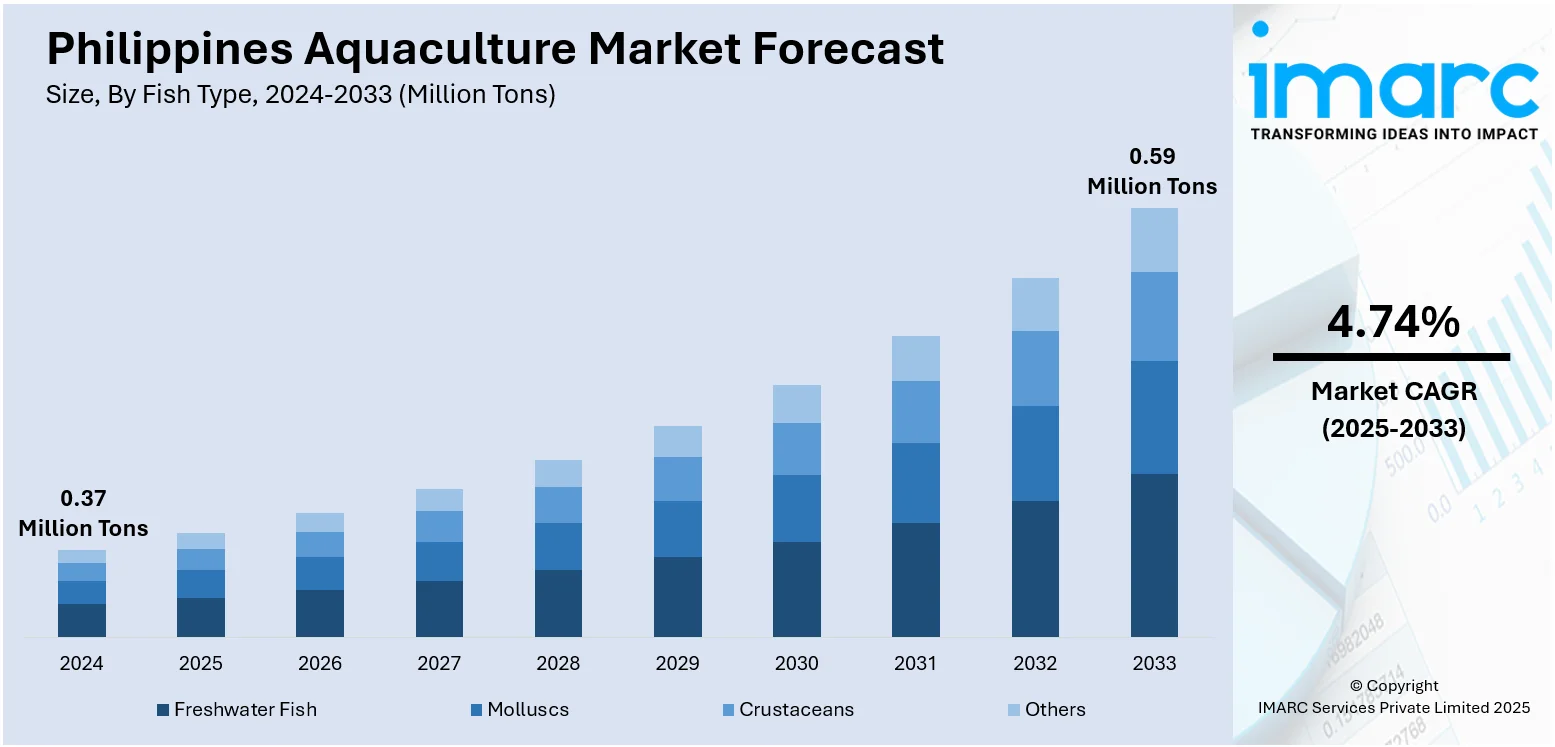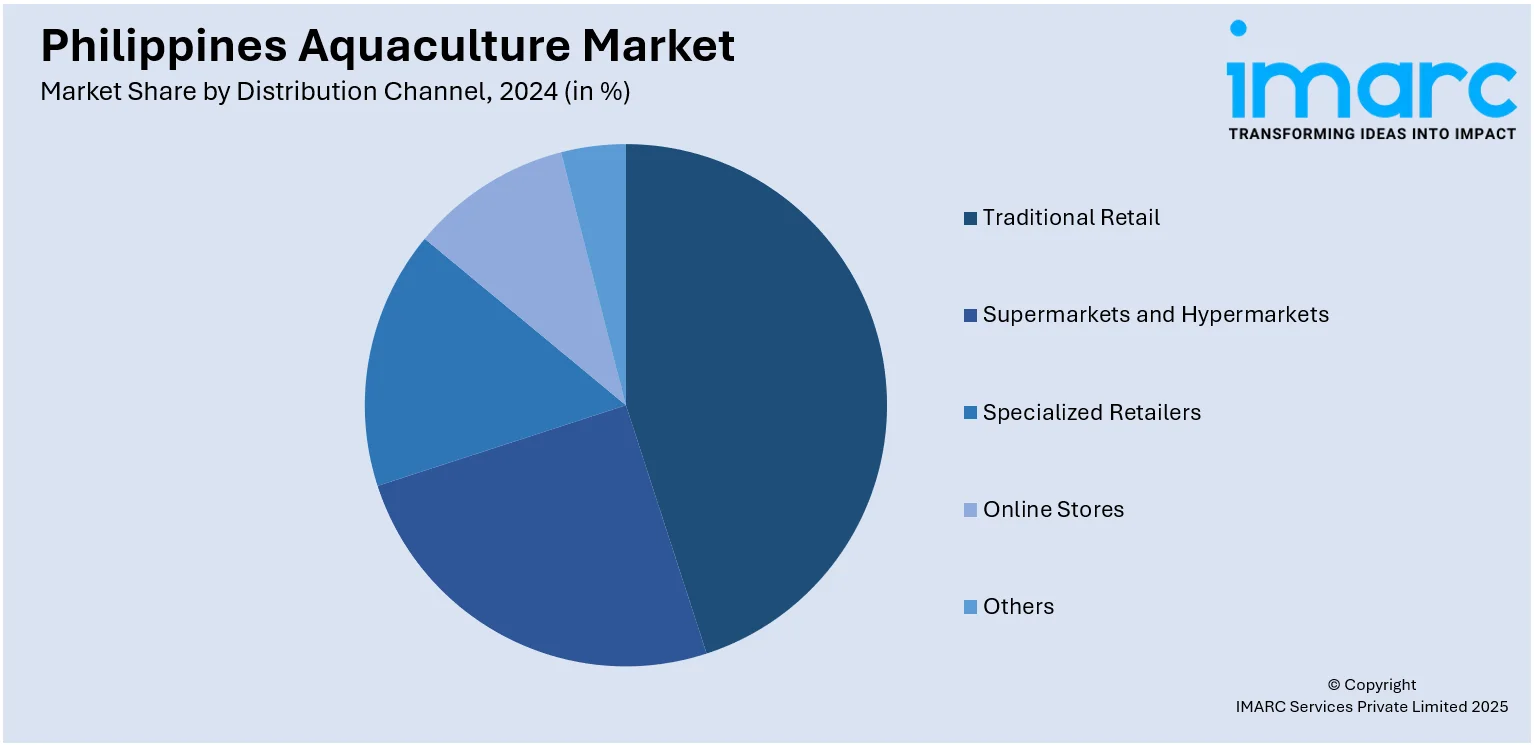
Philippines Aquaculture Market Size, Share, Trends and Forecast by Fish Type, Environment, Distribution Channel, and Region, 2025-2033
Philippines Aquaculture Market Overview:
The Philippines aquaculture market size reached 0.37 Million Tons in 2024. Looking forward, the market is projected to reach 0.59 Million Tons by 2033, exhibiting a growth rate (CAGR) of 4.74% during 2025-2033. The sector benefits from favorable government feed and trade policies, vast coastal and freshwater zones, and surging seaweed production. Advancements in RAS and eco-friendly systems further enhance efficiency. These strengths underpin its expanding Philippines aquaculture market share in both local and export markets.
|
Report Attribute
|
Key Statistics
|
|---|---|
|
Base Year
|
2024
|
|
Forecast Years
|
2025-2033
|
|
Historical Years
|
2019-2024
|
| Market Size in 2024 | 0.37 Million Tons |
| Market Forecast in 2033 | 0.59 Million Tons |
| Market Growth Rate 2025-2033 | 4.74% |
Philippines Aquaculture Market Trends:
Scale-Up of Seaweed Production and Exports
Seaweed farming remains a cornerstone of Philippine aquaculture. In 2024, seaweed aquaculture contributed a remarkable 66% of the country’s total fishery production, reinforcing its position as a top export in the sector, with national output reaching 1.4 million metric tons. Driven by rising global demand for carrageenan and related products, seaweed cultivation thrives in regions like Bangsamoro and sustains rural incomes and foreign exchange earnings. Both smallholder farmers and large-scale enterprises contribute to its growth. As global markets increasingly favor sustainable, plant-based aquaculture, seaweed’s value as a strategic seafood commodity and export driver becomes even more critical, highlighting its central role in the continued expansion of the Philippine aquaculture industry.

To get more information on this market, Request Sample
Secure Policy Frameworks and Feed Subsidies
The Philippines government actively shapes aquaculture through subsidies, open trade policies, and supportive legislation like the Fisheries Code and Agricultural Modernization Act. Import substitution in feed, lower tariffs, and investment in infrastructure and processing upgrades all reduce costs and boost competitiveness. Such measures make aquaculture more accessible for smallholders and promote scaling. The combination of regulatory stability and financial support fosters broad sectoral expansion. Consequently, Philippines aquaculture market growth is reinforced by an enabling environment that balances sustainability, profitability, and inclusivity. For instance, in September 2024, DA-BFAR launched the National Aquaculture Development and Management Plan (ADMP) 2025–2030, the first plan focused solely on Philippine aquaculture. The five-year roadmap aims to boost sustainability, productivity, and global competitiveness, while addressing environmental and market challenges. Developed through broad stakeholder consultation, the ADMP promotes equity, climate resilience, and collaboration.
Philippines Aquaculture Market Segmentation:
IMARC Group provides an analysis of the key trends in each segment of the market, along with forecasts at the region/country level for 2025-2033. Our report has categorized the market based on fish type, environment, and distribution channel.
Fish Type Insights:
- Freshwater Fish
- Molluscs
- Crustaceans
- Others
The report has provided a detailed breakup and analysis of the market based on the fish type. This includes freshwater fish, molluscs, crustaceans, and others.
Environment Insights:
- Fresh Water
- Marine Water
- Brackish Water
A detailed breakup and analysis of the market based on the environment have also been provided in the report. This includes fresh water, marine water, and brackish water.
Distribution Channel Insights:

- Traditional Retail
- Supermarkets and Hypermarkets
- Specialized Retailers
- Online Stores
- Others
The report has provided a detailed breakup and analysis of the market based on the distribution channel. This includes traditional retail, supermarkets and hypermarkets, specialized retailers, online stores, and others.
Regional Insights:
- Luzon
- Visayas
- Mindanao
The report has also provided a comprehensive analysis of all the major regional markets, which include Luzon, Visayas, and Mindanao.
Competitive Landscape:
The market research report has also provided a comprehensive analysis of the competitive landscape. Competitive analysis such as market structure, key player positioning, top winning strategies, competitive dashboard, and company evaluation quadrant has been covered in the report. Also, detailed profiles of all major companies have been provided.
Philippines Aquaculture Market News:
- In June 2025, the Philippine Senate approved the construction of a government-funded aquafeed mill in Barangay Bahit, Panay, Capiz, aiming to produce 30 metric tons of fish feed daily. Sourcing local raw materials, the facility will reduce feed costs, which account for 70% of aquaculture expenses, and boost incomes for over 1,300 fish farmers. Capiz, the nation's top milkfish producer, leads aquaculture output in Western Visayas. The project supports sustainability, food security, and regional growth, reducing dependency on imported feeds from Cebu and Manila.
- In May 2025, the FAO and BARMM launched a Japan-funded $4.7 Million project to strengthen sustainable fisheries and aquaculture in Mindanao. Building on past peacebuilding efforts, the initiative aims to support 4,000 small-scale fishers and farmers, promote food security, and empower women and youth IDPs.
Philippines Aquaculture Market Report Coverage:
| Report Features | Details |
|---|---|
| Base Year of the Analysis | 2024 |
| Historical Period | 2019-2024 |
| Forecast Period | 2025-2033 |
| Units | Million Tons |
| Scope of the Report |
Exploration of Historical Trends and Market Outlook, Industry Catalysts and Challenges, Segment-Wise Historical and Future Market Assessment:
|
| Fish Types Covered | Freshwater Fish, Molluscs, Crustaceans, Others |
| Environments Covered | Fresh Water, Marine Water, Brackish Water |
| Distribution Channels Covered | Traditional Retail, Supermarkets and Hypermarkets, Specialized Retailers, Online Stores, Others |
| Regions Covered | Luzon, Visayas, Mindanao |
| Customization Scope | 10% Free Customization |
| Post-Sale Analyst Support | 10-12 Weeks |
| Delivery Format | PDF and Excel through Email (We can also provide the editable version of the report in PPT/Word format on special request) |
Key Questions Answered in This Report:
- How has the Philippines aquaculture market performed so far and how will it perform in the coming years?
- What is the breakup of the Philippines aquaculture market on the basis of fish type?
- What is the breakup of the Philippines aquaculture market on the basis of environment?
- What is the breakup of the Philippines aquaculture market on the basis of distribution channel?
- What is the breakup of the Philippines aquaculture market on the basis of region?
- What are the various stages in the value chain of the Philippines aquaculture market?
- What are the key driving factors and challenges in the Philippines aquaculture market?
- What is the structure of the Philippines aquaculture market and who are the key players?
- What is the degree of competition in the Philippines aquaculture market?
Key Benefits for Stakeholders:
- IMARC’s industry report offers a comprehensive quantitative analysis of various market segments, historical and current market trends, market forecasts, and dynamics of the Philippines aquaculture market from 2019-2033.
- The research report provides the latest information on the market drivers, challenges, and opportunities in the Philippines aquaculture market.
- Porter's five forces analysis assist stakeholders in assessing the impact of new entrants, competitive rivalry, supplier power, buyer power, and the threat of substitution. It helps stakeholders to analyze the level of competition within the Philippines aquaculture industry and its attractiveness.
- Competitive landscape allows stakeholders to understand their competitive environment and provides an insight into the current positions of key players in the market.
Need more help?
- Speak to our experienced analysts for insights on the current market scenarios.
- Include additional segments and countries to customize the report as per your requirement.
- Gain an unparalleled competitive advantage in your domain by understanding how to utilize the report and positively impacting your operations and revenue.
- For further assistance, please connect with our analysts.
 Request Customization
Request Customization
 Speak to an Analyst
Speak to an Analyst
 Request Brochure
Request Brochure
 Inquire Before Buying
Inquire Before Buying




.webp)




.webp)












